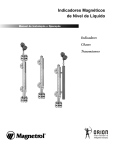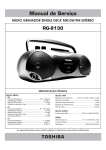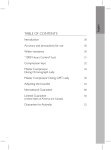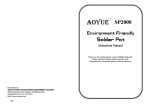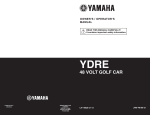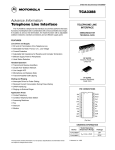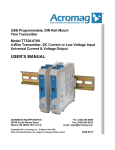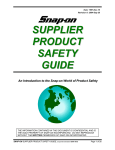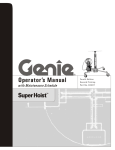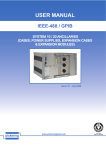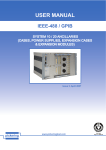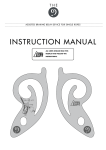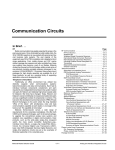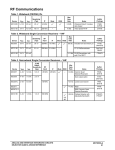Download MAINTENANCE
Transcript
MAINTENANCE 1 PERIODIC MAINTENANCE CHARTS Regular maintenance is required for the best performance and safe operation of your golf car. 2 3 4 Be sure to turn off the main switch and apply the parking brake when you perform maintenance, unless otherwise specified. If the owner is not familiar with servicing the machine, death or serious personal injury can result. When in doubt the work should be done by a Yamaha dealer or other qualified mechanic. CS - CHECK CA - CHECK AND ADJUST R - REPLACE Remarks 5 PRE-OP 6 7 8 9 10 EVERY MONTH Daily PreOperation S - SERVICE Page Charge S S S S S S 4-3/ 8-5 Clean battery tops, check for tightness of hold-down screws and terminals S S S S S S 6-2/ 8-3 Check brake pedal freeplay and adjust if necessary CS CA CA CA CA CA 6-4/ 8-10 Check steering operation CS CS CS CS CS CS 6-3 Check tire pressure, tread depth, tire surface for damage CS CA CA CA CA CA 6-2 Check body and chassis for damage CS CS CS CS CS CS 6-4 Check tightness of all bolts, nuts, screws and rivets CS CS CS CS CS CS * Check reverse alarm operation CS CS CS CS CS CS 6-3 Check electrolyte level CS CS CS CS CS 8-3/8-4 Check for loose or broken connections CS CS CS CS CS Clean/Lube pedal control area CL EVERY 6 Check all wire insulation for cracks MONTHS and/or worn spots Check shock absorbers for oil leaks and damaged springs 11 CL - CLEAN AND LUBRICATE L - LUBRICATE 40 rounds 250 rounds 500 rounds 1000 rounds 2000 rounds 250 hrs 500 hrs 125 hrs 20 hours 1000 hrs 1200 mls 2500 mls 600 mls 100 miles 5000 mls 2000 kms 4000 kms 1000 kms 160 kms 8000 kms (Every (Every 2 (Every 6 (Every (Every 4 Year) years) months) Month) years) * — CS CS CS CS * CS CS CS CS * * Items without a page number reference should be serviced by a Yamaha dealer or other qualified mechanic. This manual does not contain these procedures. They are contained in the Service Manual. 8-1 JW9 MAINTENANCE CS - CHECK CA - CHECK AND ADJUST Remarks EVERY YEAR R - REPLACE Daily PreOperation S - SERVICE CL - CLEAN AND LUBRICATE L - LUBRICATE 40 rounds 250 rounds 500 rounds 1000 rounds 2000 rounds 250 hrs 500 hrs 125 hrs 20 hours 1000 hrs 1200 mls 2500 mls 600 mls 100 miles 5000 mls 2000 kms 4000 kms 1000 kms 160 kms 8000 kms (Every (Every 2 (Every 6 (Every (Every 4 Year) years) months) Month) years) Perform a discharge test S S S * Apply Terminal protectant S S S — Check rear axle bearing play for roughness or freeplay CS CS CS * Check steering knuckle bushing freeplay / Adjust wheel alignment CA CA CA * Check wheel nut tightness, front wheel bearing play CS CS CS * Check transaxle oil level and inspect for leakage CS CS CS 8-9 Check pedal stop operation and adjust if necessary CA CA CA * EVERY 2 YEARS Replace transaxle oil EVERY 4 YEARS Inspect internal wet brake and replace pads if necessary R 1 Page 2 3 4 5 * CA * * Items without a page number reference should be serviced by a Yamaha dealer or other qualified mechanic. This manual does 6 not contain these procedures. They are contained in the Service Manual. 7 8 9 10 11 JW9 8-2 MAINTENANCE Battery Care 1 Battery electrolyte is poisonous and dangerous, causing severe burns, etc. It contains sulfuric acid. Avoid contact with skin, eyes, or clothing. Antidote: EXTERNAL: Flush with water. INTERNAL: Drink large quantities of water or milk. Follow with milk of magnesia, beaten egg, or vegetable oil. Call physician immediately. EYES: Flush with water for 15 minutes and get prompt medical attention. Batteries produce explosive gases. Keep sparks, flame, cigarettes, etc., away. Ventilate when charging or using in enclosed space. Always shield eyes when working near batteries. KEEP OUT OF REACH OF CHILDREN. 2 3 4 5 6 7 8 Six 8-volt deep cycle batteries provide power for your electric golf car and must be properly maintained and recharged for maximum performance and service life. To maintain your batteries: 1. Clean the tops of the batteries with a solution of baking soda and water, as necessary, to remove corrosion. 9 10 11 NOTICE Do not allow cleaning solution to enter battery cells. Serious battery damage can result. 2. Check the fluid level before and after charging. 8-3 JW9 MAINTENANCE Fill Well Electrolyte 1/8” Below Bottom of Fill Well Max. Level charged battery Electrolyte 1/8” (3 mm) l Before charging: only add distilled water if fluid is below the top of the plates, and then add just enough to cover plates. l After charging: open the vent caps and look inside the fill wells. Add distilled water until the electrolyte level is 3 mm (1/8") below the bottom of the fill well. A piece of rubber can be used safely as a dipstick to help determine this level. Clean, replace and tighten all vent caps. Max. Level discharged battery NOTICE 3. Using a hydrometer, check the specific gravity of the battery fluid in each cell against the readings on the chart below. Consult a Yamaha dealer if any low readings are found, or if readings vary more than one point between cells. Temperature °C °F Satisfactory Uncorrected Hydrometer Reading 48.9 120 1.244 43.3 110 1.248 37.8 100 1.252 3 4 32.2 90 1.256 26.7 80 1.260 21.1 70 1.264 15.6 60 1.268 10.0 50 1.272 4.4 40 1.276 -1.1 30 1.280 6 7 8 9 10 11 Y-936a JW9 2 5 Normal tap water contains minerals which are harmful to a battery; therefore, refill only with distilled water. Y-937c 1 8-4 MAINTENANCE Battery Charging 1 Read and understand the owner’s manual provided with your golf car’s battery charger before charging batteries. Death or serious personal injury can result from failing to comply with the safety and warning instructions affixed to the golf car or utility vehicle. 2 3 4 Explosive hydrogen gas is produced while batteries are being charged. Only charge batteries in well ventilated areas (a minimum of five air changes per hour is recommended). Death or serious personal injury can result from failing to comply with the safety and warning instructions affixed to the golf car or utility vehicle. 5 6 7 8 OFF REV FWD ON 9 To charge the batteries in your golf car, follow the instructions contained in your battery charger’s owner’s manual. The following is a summary of the charging steps. 1. Turn main switch key to “OFF” position. 10 Y-912 NOTICE Always put the tow switch in the “TOW” position before charging battery or damage to the electrical system may result. 11 2. Lift up the seat and move the tow switch to the TOW position. 8-5 JW9 MAINTENANCE NOTICE Use only battery chargers that are rated for use with 48-volt Yamaha Golf Cars. Serious battery damage can result. Thoroughly read and understand the user manual supplied with your 48-volt charger. 3. With the charger properly connected and grounded (see charger’s owner’s manual), insert the DC output into the golf car receptacle. Y-669c POWER ON A ERROR1 B ERROR2 C CHARGING 90% CHARGED D E Do not disconnect the DC output cord from the battery receptacle when the charger is on or an arc could occur that may cause an explosion. Death or serious personal injury can result from failing to comply with the safety and warning instructions affixed to the golf car or utility vehicle. å ∫ ç ∂ fl Power ON Light (Red) Error Light 1 (Red) Error Light 2 (Red) Charging Light (Yellow) Charged Light (Green) 4. When the charger is plugged into the AC power, the Power ON Light illuminates continuously. 5. If Error 1 or Error 2 light is blinking, there is a problem with the batteries or the charger. Contact your Yamaha Dealer. Y-1559 JW9 6. During normal charging, the Charging Light blinks or continually illuminates. 7. The charger turns off automatically when the batteries reach full charge. 8-6 1 2 3 4 5 6 7 8 9 10 11 MAINTENANCE 8. After the charger has turned off, disconnect the DC output plug from the golf car receptacle by grasping the plug body and pulling the plug straight out of the receptacle. 1 2 Battery Installation 3 When working with batteries, do not put wrenches or other metal objects across the battery terminals. An arc can occur causing an explosion or fire at the battery. Death or serious personal injury can result from failing to comply with the safety and warning instructions affixed to the golf car or utility vehicle. 4 5 6 C B A Y-751D 7 1. Install the battery holddown plates and torque to 7-9 Nm, 0.70.9 m•kg (62-80 in•lb) as shown. å Forward ∫ Battery ç Battery holddown plate 8 2. Connect the wire leads and torque to 9-10 Nm, 0.9-1.0 m•kg (80-89 in•lb) as shown. 9 10 Y-672h 11 8-7 When installing batteries: l Carefully place battery cables and hold-downs making sure that cables do not lay across vent caps. l Always remove the negative (–) cable to the motor controller first, and install it last. A spark can occur causing an explosion or fire at the battery. Death or serious personal injury can result from failing to comply with the safety and warning instructions affixed to the golf car or utility vehicle. JW9 MAINTENANCE NOTICE 1 Do not overtighten the battery holddown nuts. Excessive force will damage the battery casing. 2 Fuse Replacement 3 B A Y-523a Be sure to use the specified fuse. Using a wrong fuse can cause electrical system damage and create a fire hazard. Death or serious personal injury can result from failing to comply with the safety and warning instructions affixed to the golf car or utility vehicle. 4 5 6 Fuse Type: 3 Amp, Blade Style NOTICE 7 When replacing a fuse be sure the main switch is turned off to prevent accidental shortcircuiting and electrical system damage. 8 1. Locate the in-line fuse holder on the main wire harness adjacent to the tow switch. 2. Pull fuse holder cover off. 9 10 3. Pull fuse out, inspect and replace if necessary. 11 å Fuse holder ∫ Fuse JW9 8-8 MAINTENANCE Transaxle Oil 1 To check transaxle oil level: 1. Place the golf car on a flat, level surface. 2 3 1 3 2. Remove seven plastic rivets 1 and two bolts 2, and remove the bag holder insert 3. 3. Place an oil pan under the transaxle case. 2 4. Clean area around servicing plug 4. 4 5 Y-1994 5. Using an 8 mm hex wrench, remove transaxle oil servicing plug located on the rear of the transaxle case. 6. Transaxle oil should be at the top of the oil servicing hole or just beginning to run out of hole. 6 NOTICE 4 Do not allow foreign material to enter transaxle. Serious transaxle damage can result. 7 8 Y-1214 9 7. If needed, add Yamalube Friction Modified Shaft Drive Gear Oil until it is at the top of the plug hole or just beginning to run out of servicing hole. TIP The YDRE Golf Car is equipped with an internal wet brake. Use of oil other than Yamalube Friction Modified Shaft Drive Gear Oil will cause brake noise. 10 11 8. Install the transaxle servicing plug and tighten to 14-19 Nm, 1.4-1.9 m•kg (120-168 in•lb). 9. Install the bag holder insert 3 and secure with two bolts 2 and seven plastic rivets 1. 8-9 JW9 MAINTENANCE TIP For transaxle oil replacement, consult a Yamaha dealer or other qualified mechanic. 1 2 NOTICE Before performing wheel or brake maintenance, verify that the main switch is in the “OFF” position. Serious transaxle damage can result. Y-57 3 4 Wheel Replacement To remove and install a wheel on your golf car: 1. With the wheels blocked to prevent the golf car from moving, loosen the wheel nuts. 2. Elevate the golf car with a jack and remove the wheel nuts and the wheel. 3. Reverse the removal steps when installing the wheel. Wheel nut tightening torque: 80 Nm, 8.0 m.kg (58 ft.lb) 5 6 7 8 Brake Adjustment The brakes on your golf car are self-adjusting. Before you operate the car, press down on the brake pedal several times to make sure the brakes are functioning properly. 9 10 11 Consult your Yamaha dealer before using your golf car if you suspect brake problems. Death or serious personal injury can result from failing to comply with the safety and warning instructions affixed to the golf car or utility vehicle. JW9 8-10 MAINTENANCE Brake Pedal Free Play Adjustment 1 NOTICE 2 Before adjusting brake pedal free play, pump the brake pedal several times to self-adjust the brakes. 3 To adjust the brake pedal free play: 1. Remove the floor mat and service lid from the floor of the golf car. 4 5 6 Y-61c 7 a 8 8 9 10 11 12 13 14 15 16 17 2. Check the brake pedal free play by pressing against the pedal with two fingers (using light force) and measuring the distance the pedal travels before resistance is felt. 18 Brake pedal free play Å: 45-50 mm (1.77-1.96 in.) 7 9 Y-62b 10 A B 11 3. If the free play distance needs adjusting, loosen the lock nut å (under rubber bushing) and turn the adjusting nut ∫ in or out until free play specification is met. Then tighten the lock nut in place. NOTICE Y-909D 8-11 Do not over-tighten the brake cables. Over-tightening will increase brake wear and affect overall performance of car. Premature brake wear can result. JW9











